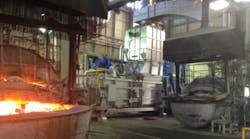Furnace builder StrikoWestofen Group delivered two StrikoMelter melting furnaces to aluminum foundries in South Korea earlier this year – its first installations in that country. Both projects involved two-chamber melting furnaces.
StrikoWestofen manufactures thermal processing equipment for light metal casting, including diecasting, gravity casting, sand casting, and low-pressure casting. The two projects in South Korea presented different objectives, the first to outfit a new automotive foundry, and the second to modernize an ongoing operation.
The Il Gangh project is an entirely new foundry near Gimhae, built to high-tech standards, including an MH II two-chamber StrikoMelter furnace at the core of its melting process. The developer added that process reliability is enhanced by an automatic weighing system and process visualization. “Besides the excellent energy efficiency of our system, the crucial point for Il Gangh was in particular the low metal loss,” StrikoMelter sales manager Thomas Platzer explained.
The potential for operating cost savings also was the decisive factor for Inzi Amt, an automotive caster in Dangjin. Like Il Gangh, Inzi Amt manufactures diecast parts, including gear housings and cylinder heads. It replaced a locally built furnace with a StrikoMelter system, and besides achieving a considerable increase in process reliability, the new system approximately halves the energy consumption.
The energy consumption of 120 m³ of natural gas per metric ton of molten aluminum has been reduced to a nominal consumption of less than 60 m³ of natural gas per metric ton, according to the furnace builder. The improved efficiency also is evident by the reduction metal loss made possible by the EtaMax shaft geometry.
“The basic raw materials are preheated via targeted use of the waste heat produced during the melting and holding process, thus allowing an extremely rapid melting process to be achieved. This reduces the entry of oxides and consequently the metal loss,” Platzer explained. “The excellent result - a loss of less than 1.5% - has been confirmed empirically by many foundries worldwide.
“In field tests, they have now been validated for the South Korean market too, making them a reliable basis for those deciding on future investments in furnaces in the region,” he said.
“We are now facing concrete inquiries from South Korean foundries,” Platzer said, noting the influence of the two installations. “Now that the excellent consumption values of our systems, in particular the low metal loss, have been confirmed via measurements made by the South Korean operators, we will be able to stand up well to the stiff local competition on the South Korean market, too.”
South Korean producers of aluminum casting have registered high growth rates for several years, doubling their total production volume between 2008 and 2012. In the 2011, 54% of all of the world’s aluminum cast parts were produced in Asia, and that trend is continuing to rise. “In the Asian market in particular, and specifically in South Korea, there is an enormous potential for increasing the efficiency of the systems,” according to StrikoWestofen CEO Rudolf Riedel. “That’s why we are so happy that we have now implemented the first projects in South Korea.”










